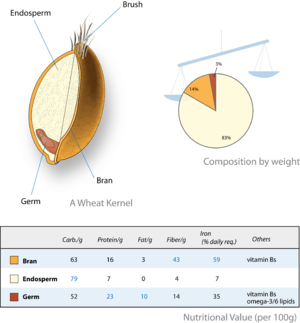Cereal germ facts for kids
The germ is a tiny but mighty part of a cereal grain, like a wheat or corn seed. Think of it as the "baby plant" or embryo inside the seed. It's the part that would sprout and grow into a new plant if planted!
When grains are processed to make things like white flour, the germ is often removed. This happens during a process called milling. The germ is taken out along with the bran (the outer layer of the grain). Removing the germ helps the flour stay fresh longer because the germ has natural fats that can spoil over time.
However, the germ is full of good things! It's kept in whole-grain foods, which are much healthier. Sometimes, oil is even pressed from the germ, like wheat germ oil or rice bran oil.
What is Wheat Germ?
Wheat germ is a super healthy part of the wheat kernel. It's packed with important nutrients your body needs. These include vitamin E, folate (also known as folic acid), phosphorus, thiamin, zinc, and magnesium. It also has healthy essential fatty acids and lots of fiber.
When you eat white bread, it's usually made from flour where the germ and bran have been removed. This makes the bread white but takes away many of the good nutrients.
How to Use Wheat Germ
Wheat germ is easy to add to your food to make it healthier! You can sprinkle it into many different meals and snacks:
- Add it to protein shakes or smoothies.
- Mix it into casseroles or muffins.
- Stir it into your morning cereal or yogurt.
- Bake it into cookies or pancakes.
Storing Wheat Germ
Because wheat germ has natural oils, it can go bad, or become rancid, if not stored correctly. To keep it fresh, always store wheat germ in a refrigerator or freezer. Keep it away from sunlight too!
Some companies use special ways to keep wheat germ fresh. They might store it in vacuum-sealed containers or put small packets inside the packaging that absorb oxygen. This helps it stay good for longer.
| Nutritional value per 100 g (3.5 oz) | |
|---|---|
| Energy | 1,598 kJ (382 kcal) |
|
51.8 g
|
|
| Sugars | 7.8 g |
| Dietary fiber | 15.1 g |
|
10.7 g
|
|
| Saturated | 1.83 g |
| Monounsaturated | 1.5 g |
| Polyunsaturated | 6.62 g |
|
Protein
|
29.1 g
|
| Vitamins | Quantity
%DV†
|
| Thiamine (B1) |
145%
1.67 mg |
| Riboflavin (B2) |
68%
0.82 mg |
| Niacin (B3) |
35%
5.59 mg |
| Pantothenic acid (B5) |
28%
1.387 mg |
| Vitamin B6 |
75%
0.978 mg |
| Folate (B9) |
88%
352 μg |
| Vitamin C |
7%
6 mg |
| Vitamin E |
107%
15.99 mg |
| Minerals | Quantity
%DV†
|
| Calcium |
5%
45 mg |
| Iron |
70%
9.09 mg |
| Magnesium |
90%
320 mg |
| Manganese |
950%
19.956 mg |
| Phosphorus |
164%
1146 mg |
| Potassium |
32%
947 mg |
| Zinc |
175%
16.67 mg |
| †Percentages estimated using US recommendations for adults. | |
See also
 In Spanish: Germen de cereal para niños
In Spanish: Germen de cereal para niños


